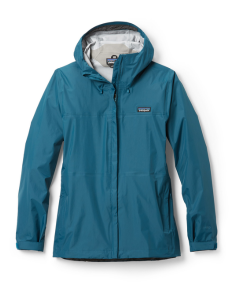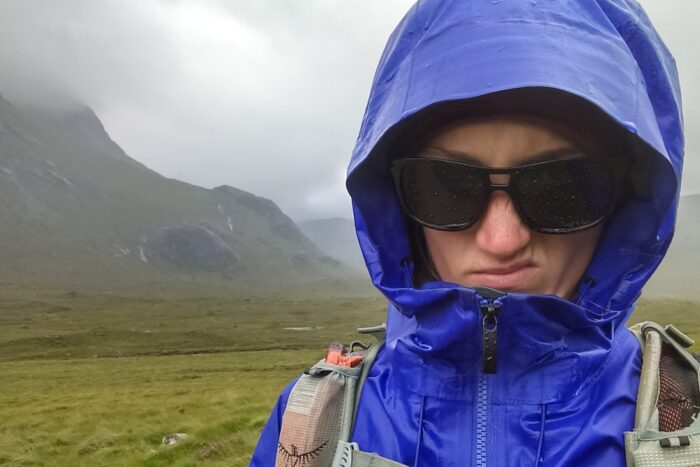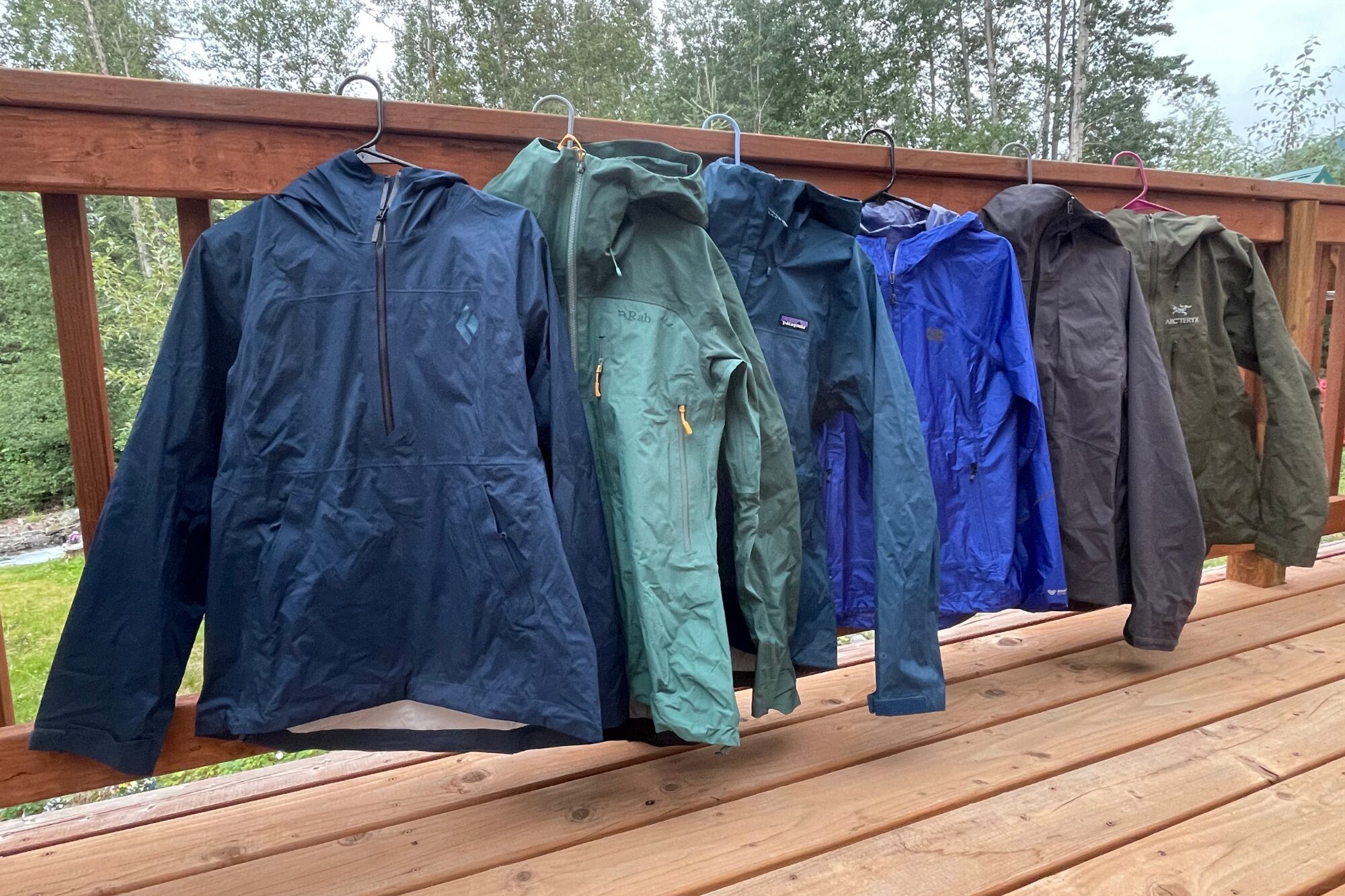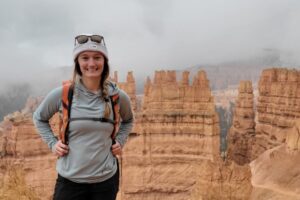If you spend enough time outdoors, getting caught in the rain is inevitable. Thankfully, with the right rain jacket, it doesn’t have to be painful.
However, not all jackets are created equal. Some are more storm-worthy than others, and different jackets offer different comfort levels, breathability, durability, and features. The ExplorersWeb team put over a dozen different rain jackets to the test to create this guide. Our efforts were led by Gear Editor Chelsey Cook, a professional mountain guide in some of the wettest places in the world.
Throughout our testing process, we considered waterproofing, layers, breathability, and features. The ExplorersWeb team tested rain jackets in some of the wettest places around, including the Pacific Northwest, Alaska, and the United Kingdom. We looked for comfortable, durable rain jackets that could perform season after season in everything from a drizzle to a downpour.
Our Picks for the Best Rain Jackets:
- Best Overall Rain Jacket: Arcteryx Beta AR
- Best Value Rain Jacket: Patagonia Torrentshell 3L
- Best Ultralight Rain Jacket: Outdoor Research Helium
- Most Comfortable Rain Jacket: Rab Kinetic Alpine 2.0
Best Overall Rain Jacket:
Arcteryx Beta AR
Features:
- Hardwearing N80d Most Rugged 3-layer GORE-TEX Pro reinforces high-wear areas
- Helmet-compatible hood with microsuede chin guard
- Taped seams for increased waterproofness
- Longer length for added protection over hips and back
- 2 hand pockets, high enough to use with a harness
- Contains materials that meet the bluesign® criteria
Why we like it: Ridiculously stormproof, keeps wind and water out all day long
What we don’t like: Material can feel stiff and is noisy, expensive
Waterproof Membrane: 3-layer GORE-TEX Pro | Length: Hip-length | Ventilation: Pit zips | Weight: 16 oz.
The Arcteryx Beta AR ($600) is our pick for the best overall rain jacket thanks to its incredible weatherproofing, light weight, and durability. Chelsey spent two seasons guiding backpacking trips in some of the wettest Alaskan summers on record in a sub-par rain jacket before she switched to the Beta AR. She hasn’t looked back since and wouldn’t dream of relying on any other jacket to keep her warm and dry in the worst weather, whether she’s backpacking or climbing.
The Beta AR features an incredibly waterproof GORE-TEX Pro Most Rugged membrane and taped seams, keeping water out in even the rainiest conditions. It also has a generous cut and long length, perfect for layering under on those truly heinous days. Pit zips help keep you from sweating in warmer conditions, and the hood fits over most climbing helmets.
The jacket is very comfortable, but the material does feel a bit stiff and is noisy. For that reason, it’s better suited to true backcountry wear, and you may want a softer, quieter jacket to wear around town. And, while the price tag may seem steep, we think it’s well worth the cost.
Check Women’s Price at Arcteryx
Best Value Rain Jacket:
Patagonia Torrentshell 3L
Features:
- Three-layer H2No waterproof membrane
- PFC/PFAS-free, 100% recycled nylon fabric
- Adjustable hood that stows away
- Two hand warming pockets; jacket stuffs into the left pocket
- Pit zips for increased ventilation
Why we like it: Sustainable and well-priced
What we don’t like: Stiff, plastic-y feeling fabric, no chest pocket
Waterproof Membrane: H2No® Performance Standard 3-layer shell | Length: Hip-length | Ventilation: Pit zips | Weight: 14 oz.
The Patagonia Torrentshell 3L ($179) features a three-layer H2No waterproof membrane at an incredible value. The three-layer construction is weatherproof and durable, keeping you dry for years to come. The lining is also a soft tricot, increasing comfort and preventing the clamminess that you usually feel while wearing a wet rain jacket. The jacket features an adjustable hood that you can stow away, as well as pit zips and two pockets.
The Torrentshell is also PFC-free and made of 100% recycled nylon ripstop fabric, with Fair Trade sewing. The fabric does feel stiffer and crinklier than softer jackets like the Rab Alpine Kinetic 2.0. However, it’s by far the most affordable, 3-layer rain jacket in this guide and well worth the investment.
Best Ultralight Rain Jacket:
Outdoor Research Helium
Features:
- 2.5 layer fabric with taped seams for increased weatherproofing
- Adjustable hood, with an elastic hem and elastic cuffs to seal out moisture
- Zipped chest pocket that doubles as a stuff sack
- Reflective logo and forearm overlays
Why we like it: Ultralight, affordable, relatively durable
What we don’t like: Doesn’t breathe well, very few features
Waterproof Membrane: 2.5-layer Pertex Shield Diamond Fuse | Length: Hip-length | Ventilation: None | Weight: 6.3 oz.
The Outdoor Research Helium ($170) is our pick for the best ultralight rain jacket. Pertex’s Diamond Fuse fabric is durable and tear-resistant while still being incredibly lightweight. At 6.3 ounces, the Helium is half the weight of other jackets in this guide and stuffs into its own chest pocket. The light weight is also accomplished by streamlining the jacket; the Helium doesn’t have many features, but the ones it does are well thought out. An adjustable hood, elastic hem, and elastic cuffs help seal out moisture, while a reflective logo and forearm overlays are a great addition for road runners.
While this jacket doesn’t have the same weatherproofing as a true 3-layer rain jacket, it can manage light to moderate rainfall, making it a great option as an emergency rain jacket or for running the rain. Just remember that heavy downpours will overwhelm the fabric, and leave it sticking to your skin. There also aren’t any pit zips to help you shed heat when the temperatures rise.
Most Comfortable Rain Jacket:
Rab Kinetic Alpine 2.0
Features:
- Recycled stretch-knit Proflex™ fabric
- Nylon woven Proflex panels in the hips, arms, shoulders, and hood handle abrasion and exposure
- Helmet-compatible hood with front and rear adjustments
- Designed for alpine climbing and mountaineering
Why we like it: Comfortable, stretchy, soft against the skin
What we don’t like: No pit zips, not as waterproof as other jackets
Waterproof Membrane: 3-layer waterproof | Length: Hip-length | Ventilation: Core vents | Weight: 14.9 oz.
The Rab Kinetic Alpine 2.0 ($310) is the jacket that almost made this buyer’s guide impossible to complete. Not because it was so bad – because it was so good. The Kinetic Alpine is so ridiculously comfortable that Chelsey had a hard time taking it off to test any of the other rain jackets. The soft fabric feels more like a softshell than a rain jacket, and the relaxed fit means you can easily layer underneath it.
As stated in the name, the Alpine 2.0 was designed for alpine adventures. The two hand pockets are placed high, allowing you to access them while wearing a harness, and adjustable cuffs will fit over most gloves. The hood is helmet-compatible and adjustable, and woven panels in the hips, arms, shoulders, and hoods increase the jacket’s durability where it needs it most. The Alpine 2.0 isn’t the most waterproof option in this buyer’s guide, however, and is better suited to light to moderate rain than a true downpour. It also doesn’t have any pit zips.
About our testing process

There are not many things worse than a fully wetted-out rain jacket. Photo: Chelsey Cook
The ExplorersWeb team has tested over a dozen rain jackets, from ultralight running jackets to technical hard shells designed for the alpine. Gear Editor Chelsey Cook began this guide in July 2024. She has over twenty years of experience hiking, backpacking, and mountaineering, and relies on rain jackets to keep her dry and happy in the backcountry. Chelsey has had the pleasure of living in the Pacific Northwest, renowned as one of the wettest places in the world during the winter. She also frequently travels to Scotland, England, and the Faroe Islands, famously rainy places, and guided backpacking trips through two of the wettest Alaskan summers in recent memory. A rain jacket is a standard part of any outfit she wears, and she’s extensively tested numerous brands and styles.
Chelsey tested the rain jackets in this guide while backpacking in Alaska’s Arctic, trekking the Salkantay Trail to Machu Picchu in Peru, guiding volcanoes in the Pacific Northwest, and wearing them in her day-to-day life in Alaska. She tested their versatility while running, backpacking, and skiing and their durability by climbing and scrambling over rocks. Chelsey also wore them in different climates, from the warm temperatures near the equator to the frigid cold of the Alaska Range.
She looked for rain jackets with different fits and purposes, as well as value rain jackets, technical rain jackets, and ultralight rain jackets. This guide will continue to grow and change as we test new rain jackets.
Things to consider when buying rain jackets

Rain jackets will vary in weight and size depending on the layers of fabric used and their features. Photo: Chelsey Cook
Waterproofness
When shopping for outdoor gear, you’ll see terms like “water-resistant” and “waterproof”. Water-resistant jackets will shed water in light rain and are often breathable, but they aren’t completely waterproof or suitable as rain jackets. Waterproof jackets, on the other hand, have a built-in laminate layer or coating that blocks outside moisture from entering. They also have taped seams for increased waterproofing.
Forever chemicals, known as PFAS or PFCs, were frequently used to make fabric waterproof and water-resistant. However, they have been linked to long-term health effects, and many states are beginning to ban their use in textiles. Rain jackets like Patagonia Torrentshell 3L are already PFAS-free.
Breathability
Breathability is key in a rain jacket. Without it, you’ll feel more like you’re wearing a garbage bag than a rain jacket. Not only is this uncomfortable, but your sweat also has nowhere to go and will leave you cold and clammy, defeating the purpose of the rain jacket. Lower-end rain jackets generally aren’t as breathable as higher-end ones; the Rab Kinetic Alpine 2.0 is by far the most breathable rain jacket we’ve tried, but also not the most budget-friendly.
Some jackets have also increased their breathability by adding ventilation options, like pit zips. These are a great way to dump heat in warmer conditions or while working hard.
Fabric layers
Rain jackets typically consist of a combination of layers, which not only make them waterproof but also let sweat and hot air out. Rain jackets come in 2, 2.5, and 3 layers. Rain jackets with 2 layers are the most basic and generally have a mesh liner to protect the jacket’s inner coating. They’re not very breathable and, because of the mesh, are often bulky and heavy. They are, however, budget-friendly and are a great entry-level option, especially for the frontcountry. We didn’t feature any in this guide.
A 2.5-layer rain jacket, like the Outdoor Research Helium, has a thin interior fabric attached to the waterproof coating. This makes them more lightweight and compressible than a 2-layer jacket.
A 3-layer rain jacket has three separate fabrics: a waterproof membrane, a breathable membrane, and then an interior fabric. They’re more bulky than 2.5-layer jackets, but also more durable, more comfortable, and wick moisture better. They’re also the most expensive, but well worth the cost if you’ll be spending a lot of time in your rain jacket.

The Arcteryx Beta AR is a three-layer jacket, with a waterproof membrane, a breathable membrane, and an interior fabric. Photo: Chelsey Cook
Weight
Most of the full-size rain jackets in this guide weigh around one pound, which is pretty standard. Lightweight jackets, like the Outdoor Research Helium, weigh only half that; however, they don’t offer as much protection or features. Generally speaking, the more durable and feature-laden the jacket, the more it will weigh. The Arcteryx Beta AR is the heaviest jacket in this guide, and it’s also the most durable and waterproof. While it’s a great option for long trips and bad weather, it (and its weight) may be overkill for many day hikes or good weather days.
Features
Most rain jacket features come down to pockets, hoods, and ventilation. Rain jackets typically have at least two hand-warming pockets, and some may have an additional chest pocket. Ultralight jackets, like the Outdoor Research Helium, may have no hand pockets to save weight. If you plan on wearing your rain jacket with a climbing harness, look for one with a chest pocket, or hand pockets that are placed higher up, so you can still access them while in harness.
A good hood is a big factor in helping keep the rain out. Rain jacket hoods are typically adjustable; if you plan on wearing your rain jacket in truly stormy weather, look for one with a visor to keep the rain out of your face and a high collar. If you plan on wearing your rain jacket with a helmet, make sure the hood is helmet-compatible.
Lastly, some rain jackets have vents to help you shed hot air when you’re working hard. Common venting solutions are pit zips, side zips, and core vents. Jackets in this guide only have pit zips. If you plan on sweating a lot or live in a warm, humid place, consider getting a rain jacket with venting options.

The OR Helium is by far the lightest jacket in this guide and is low on features. It does, however, have a reflective strip on the forearm and a reflective logo. Photo: Chelsey Cook
Frequently asked questions about rain jackets
What is the best waterproof rain jacket??
While we think that the Arcteryx Beta AR is the best waterproof rain jacket, the best one for you is one that fits your needs and budget and is comfortable to wear. When choosing the right rain jacket for you, consider waterproofing, features, fit, weight, and durability.
My jacket lost its waterproofing. What happened?
Waterproof membranes slowly degrade over time and can be negatively affected by sweat and dirt. If your rain jacket doesn’t seem as waterproof as it used to be, try cleaning with with a detergent made for waterproof fabric, and re-waterproof it with a new DWR finish, with a product like NikWax.
When do I need to take a rain jacket hiking?
Personally, Chelsey always carries a rain jacket when hiking, even if the weather calls for sun. Rain jackets are not only great for keeping the wet out, but they also are good wind layers and an important emergency item if the worst should happen. If you live in an area that is rarely rainy, consider carrying a lightweight rain jacket like the Outdoor Research Helium. At just over 6 ounces, you’ll hardly notice it in your pack until you need it.






